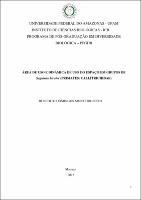| ???jsp.display-item.social.title??? |


|
Please use this identifier to cite or link to this item:
https://tede.ufam.edu.br/handle/tede/6921| ???metadata.dc.type???: | Dissertação |
| Title: | Área e uso do espaço de Saguinus bicolor (Primates: Callitrichidae) |
| Other Titles: | Home range and dinamic of the use of space in groups Saguinus bicolor (Primates: Callitrichidae) |
| ???metadata.dc.creator???: | Monteiro Neto, Benedito Domingos  |
| ???metadata.dc.contributor.advisor1???: | Gordo, Marcelo |
| ???metadata.dc.contributor.referee1???: | Frische, Cintia Cornelius |
| ???metadata.dc.contributor.referee2???: | Spironello, Wilson Roberto |
| ???metadata.dc.contributor.referee3???: | Kaefer, Igor Luis |
| ???metadata.dc.description.resumo???: | Diversos estudos apontam a relação entre movimentação de grupos de primatas e locais com alguma presença de fontes alimentares disponíveis. O propósito deste estudo é avaliar os padrões de uso do espaço por grupos de Saguinus bicolor. Seis grupos foram habituados, capturados e monitorados de 8 a 10 dias completos, em áreas de floresta na região de Manaus, AM. Para todos os grupos foram estimados a área de uso através do programa Quantum Gis®, com a o Mínimo Polígono Convexo (MCP) e Estimativa de Densidade Kernel. Utilizamos o método de grade com quadrados regulares (50x50m), o mesmo programa foi utilizado pra criar oito parcelas (50x50m) que foram montadas sobre os locais com Alta (AIU) e Baixa Intensidade de Uso (BIU) de cada grupo. Nessas parcelas, foram realizados levantamentos florísticos registrando informações quantitativas e qualitativas de árvores com frutos. Com esses dados comparamos a diversidade e abundância dentro e entre as áreas ocupadas pelos grupos. Os grupos apresentaram variação significativa no tamanho de área de uso total entre si (H = 36.7; p = 0.001) e o deslocamento tem relação com o tamanho médio da área utilizada (R2= 0.85; p = 0.006). Foi encontrada diferença significativa no número de árvores frutificando (t = 3.34; p = 0.02), árvores com frutos disponíveis (t = 4.151; p = 0.008) e número de espécies frutificando (t = 4.33; p = 0.007) entre áreas de AIU e BIU. Apesar dos grupos utilizarem área de uso com tamanho aproximado, houve grande variação entre a dimensão da área e deslocamento por dia, refletindo comportamentos de uso de área singular dos grupos. No geral, os grupos de S. bicolor exploram a área de maneira semelhante, permanecendo maior parte do tempo em locais com maior disponibilidade e diversidade de frutos, indicando que esse Primata tem comportamento conservador no uso do hábitat, investindo tempo em locais com reconhecida agregação de fontes alimentares. |
| Abstract: | Several studies indicate that the daily paths of primates groups are associated to places with presence of available food sources. The purpose of this study is to assess the patterns of size of home range and space use for Saguinus bicolor. A total of six groups were captured and monitored from 8 to 10 full days. For all groups were estimated the range of use through the ArcGis ® program with extension Animal Movements Analysis selecting the Minimum Convex Polygon function (MCP). For space use pattern, were used the method of regular square grid (50x50m) through the Quantum GIS Program 1.8 that allows you to create a grid on the total distribution of vector points. This, was used to create eight plots (50x50m) were mounted on the sites with high (HIU) and low intensity of use (LIU) of each group. In these plots, floristic surveys were carried out quantitative and qualitative information logging of trees with fruit. With these data were able to compare diversity and abundance within and among the areas occupied by the groups. The groups showed significant variation in the total home range size each other (H = 36.7; p = 0.001) and the displacement is related to the average size of the used area (R2 = 0.85; p = 0.006). Significant differences were found in the number of fruiting trees (t = 3.34; p = 0:02), trees with available fruit (t = 4.151, p = 0.008) and number of fruiting species (t = 4:33; p = 0.007) between areas of AIU and BIU. Despite the use of groups using area with approximate size, there was great variation between the size of the area and displacement per day, reflecting behavior of natural area of use of the groups. Overall, S. bicolor groups exploit similarly area, staying most of the time in places with greater availability and variety of fruits, indicating that this primate has conservative behavior in the use of habitat by investing time in places with recognized aggregation dietary sources. |
| Keywords: | Área de uso Uso do espaço Árvores frutificando Saguinus bicolor Range Space use Fructifying trees |
| ???metadata.dc.subject.cnpq???: | CIÊNCIAS BIOLÓGICAS |
| Language: | por |
| ???metadata.dc.publisher.country???: | Brasil |
| Publisher: | Universidade Federal do Amazonas |
| ???metadata.dc.publisher.initials???: | UFAM |
| ???metadata.dc.publisher.department???: | Instituto de Ciências Biológicas |
| ???metadata.dc.publisher.program???: | Programa de Pós-graduação em Diversidade Biológica |
| Citation: | MONTEIRO NETO, Benedito Domingos. Área e uso do espaço de Saguinus bicolor (Primates: Callitrichidae). 2015. 49 f. Dissertação (Mestrado em Diversidade Biológica) - Instituto de Ciências Biológicas, Universidade Federal do Amazonas, Manaus, 2015. |
| ???metadata.dc.rights???: | Acesso Aberto |
| ???metadata.dc.rights.uri???: | http://creativecommons.org/licenses/by-sa/4.0/ |
| URI: | https://tede.ufam.edu.br/handle/tede/6921 |
| Issue Date: | 14-Apr-2015 |
| Appears in Collections: | Mestrado em Diversidade Biológica |
Files in This Item:
| File | Description | Size | Format | |
|---|---|---|---|---|
| Dissertação_BeneditoMonteiroNeto_PPGDIVBIO.pdf | 2.3 MB | Adobe PDF |  Download/Open Preview |
This item is licensed under a Creative Commons License





